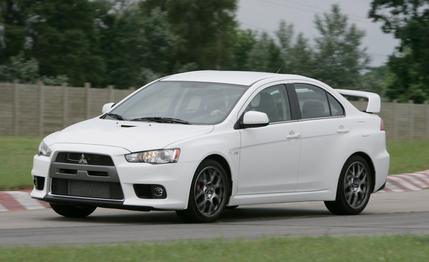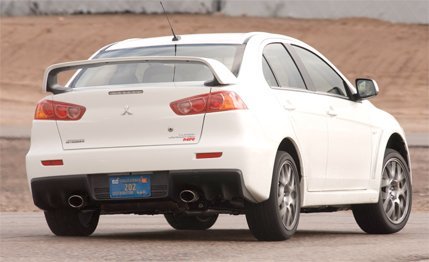
 Short Take Road Test
Short Take Road Test
For everyone besides fundamentalists, human evolution still holds great mystery. The biggest mystery, of course, is whether or not we’re still evolving. Cranial expansion seems to have plateaued, we’re doing pretty well with four fingers and opposable thumbs, and CNN has yet to cover the birth of any winged wonder babies. We may have reached our apogee. Like mankind, Mitsubishi’s Lancer Evolution has leveled off, and the company seems more concerned with growing its population than improving it noticeably. After all, the 10th-generation car is heavier—by as much as 360 pounds—than the previous car, a little softer, and not a pony more powerful, a trend that the Evo has been following all the way back to the fourth-gen car.
Following the analogy, the general Evolution populace is comprised of base GSR models, and what you might call the X-Men –style mutant genome is carried by the MR edition. The MR gains Mitsubishi’s new twin-clutch automated manual gearbox (dubbed TC-SST, it’s not available on the manual-only GSR), two-piece front brake rotors, light and sexy forged aluminum BBS wheels, Eibach springs, Bilstein dampers, and a few more inches of altitude for the rear wing (the big wing is optional on the GSR). The MR also gains a heftier sticker, draining your Twinkies-and-bottled-water emergency fund of an additional $5300, and is the priciest Evo we’ve ever tested.
Time: Now Available for Purchase from Mitsubishi
On paper, this doesn’t look like a positive mutation. In every measurable performance category, the MR we tested was slower than either of the two 10th-gen Evo GSRs to pass through our hands. Zero to 60 mph took 5.3 seconds, and the quarter-mile took 14.0 at 99 mph—the slowest Evo we’ve ever tested in a straight line—0.7 second behind the Evolution GSR to 60 mph and through the quarter. The most expensive and the slowest? Optimists could at least look at this as buying time, but we’d just call it a bummer.


Skidpad grip, although a very respectable 0.95 g, still falls short of the 0.97 g we recorded with the two GSRs. Braking distances are roughly identical as well, at 158 to 162 feet for MRs we’ve tested versus 159 to 161 for base models. Those lower numbers are largely the fault of the TC-SST transmission. Despite the weight-saving wheels and brakes, the porky 3658-pound MR we tested was a full 100 pounds heavier than the less-expensive GSR models, with about 70 pounds attributable to the transmission. And there’s a launch-control mode, but it doesn’t work very well, largely due to Mitsubishi’s own programming of the Getrag-sourced box. It revs to 5000 rpm but then engages the clutch too slowly to get a good launch or take full advantage of the turbo—the clutches in the car are too small to reliably withstand the heat of repeated aggressive dumps—and shifts aren’t as quick as those enacted by other manufacturers’ double-clutch units, particularly downshifts. Come upon someone trundling along at 65 mph on the freeway and grab a two-gear downshift to get around him or her, and by the time the gears engage and the turbo spools up, that truck you planned on diving in front of will be roaring past in the left lane. Again, blame the software. (Mitsu has revised the programming since our test, but the clutches nevertheless remain a limiting factor.)
Look Past the Numbers and Tell Us How You Feel
Although we like numbers, feel is more important. This is where the MR beats the GSR, but just barely. The reduced unsprung weight and the stiffer name-brand suspension bits make the MR feel sharper and more immediate than the GSR, even if the numbers don’t show it. The MR rides better, too. And we suspect that, had we run the MR through our lane-change test, it would have slipped through the cones ahead of the GSR. At Virginia International Raceway for our annual Lightning Lap, the Evo MR proved one of our favorites through the technical sections of the track—we really love the Evo’s trick Super All-Wheel Control all-wheel-drive system—and it turned in a very good best lap of 3:13.3. That, however, only beats the previous Evo MR by 0.2 second.
The two biggest problems with the MR are the price and that the GSR is already plenty good, running 0 to 60 mph in five seconds or less and the quarter-mile comfortably in the 13s and over 100 mph. The $33,615 GSR also posts equally impressive skidpad and braking performance. To command nearly $40,000, the MR needs to offer something truly revolutionary, and a better ride and a heavy, dim-witted transmission aren’t it. Evo buyers would be better served by a GSR with the old-fashioned stick-and-pedal manual transmission and $5300 in aftermarket goodies of their choosing.